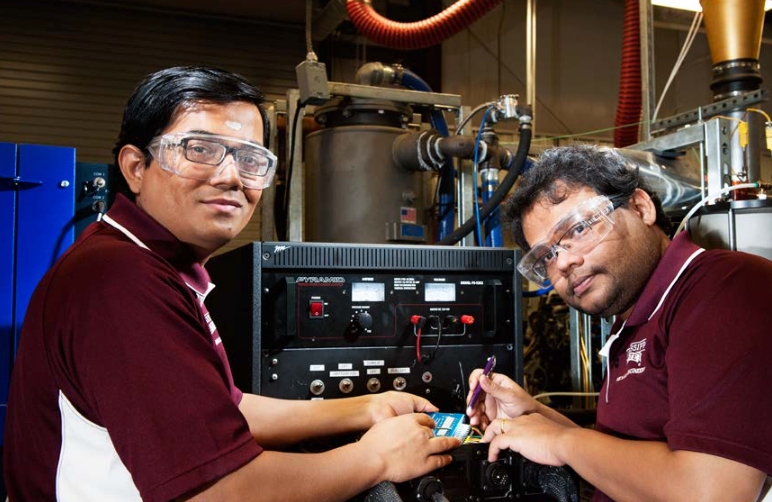Research and Students ‘ACEL’ into the Future
May 2, 2015
 CAVS scientists are designing novel engine combustion strategies for the vehicles of the future that will achieve higher fuel economy, more engine power, and are safer for the environment. This mind probing analysis is called low temperature combustion engine research. The work is supported by the creation of a new Advanced Combustion Engines (ACE) Laboratory, which when combined with MSU’s research expertise in this area, is one of the finest in the southeast.
CAVS scientists are designing novel engine combustion strategies for the vehicles of the future that will achieve higher fuel economy, more engine power, and are safer for the environment. This mind probing analysis is called low temperature combustion engine research. The work is supported by the creation of a new Advanced Combustion Engines (ACE) Laboratory, which when combined with MSU’s research expertise in this area, is one of the finest in the southeast.
“We have a 35’ x 35’ lab that is filled with test beds holding engines from a variety of classes ranging from a single-cylinder, compression-ignition research engine; an automotive-size four-cylinder, diesel engine; to a 12.9 liter, heavy duty diesel,” said Kalyan Srinivasan, associate professor of mechanical engineering.
The new ACE laboratory is only 4 years old and it was at this time that Sundar Krishnan and Kalyan Srinivasan began dedicating their careers to designing novel engine combustion strategies for vehicles that would improve fuel efficiency and power density, while at the same time reduce emissions. The two professors started at ground zero to build a lab and to establish themselves as credible researchers in the field. Meanwhile, federal fuel economy and pollution emission standards were on the rise. For that reason and due to a sluggish economy, engine manufacturers, trucking companies, and even everyday commuters have turned to researchers like Krishnan and Srinivasan for answers to cut engine fuel consumption and emissions as well as consumer costs.
“Since a lot of our industrial sector runs on diesel fuel for the transportation of goods this is an important area in which to conduct the research to develop technology that could save them money,” said Sundar Krishnan, associate professor of mechanical engineering. “Just the exhaust after-treatment devices on truck engines can cost more than $5,000, so engine manufacturers are looking for other low-cost ways to build cleaner engines, while maintaining fuel efficiency and power density.”
Although diesel engines are more fuel efficient, they have serious pollutant emissions problems. The catalytic converters that clean up pollutants created by a gasoline powered spark ignition engine do not work for diesel engines.
“Nitrogen oxides (NOx molecules) are formed in the high temperature regions in a diesel engine and they are harmful, pollutant, engine emissions.” Srinivasan further explained, “What we’ve done is to use propane as the main fuel and ignite it using a small amount of appropriately timed diesel fuel injection. Basically, the diesel ignites the propane mixture—diesel is easier to ignite—so, we reduce the diesel amount and provide most of the fuel energy from propane. As a result, there is better diesel disbursement in the combustion chamber and that reduces the hot spots, so we try to keep those temperatures down by dispersing the diesel. Now, we don’t have those hot regions where NOx form. We’ve cut those pollutants without any after-treatment. Another advantage—we run this whole combustion system with excess air, and that allows for the efficient use of the fuels and keeps the smoke emissions low.” Yet, Krishnan and Srinivasan will tell you there isn’t the so called “silver bullet” for a solution, because while they have discovered a way to eliminate NOx and smoke pollution, the catch is, in doing so, other pollutants like unburned hydrocarbons and carbon monoxide go up. It’s frustrating because both are environmental toxins and cause a loss of fuel efficiency, which is the main benefit of using diesel engines.
“It is kind of like playing the game Whack-a-mole,” Srinivasan said. “We have three major things that we try to deal with in an engine, fuel efficiency, pollutants, and power density and these three don’t simultaneously work together. If you devise a strategy to reduce one, the other two are going to go up or will be compromised. Our challenge is to devise a strategy to whack all three down and get them to be compliant.”
A local original equipment manufacturer (OEM) of engines and the Propane Education and Research Council who fund Krishnan and Srinivasan’s work realize there is no easy solution, and the achievements they have accomplished so far have brought them one step closer to the solution of building the kind of clean, fuel-efficient engines that consumers want. In the meantime, the other advantage is the investment in their research is also training the next generation of engineers who will develop the engines for the new vehicles of the future.
“Everything in our lab is student-built. That is a lot of value added to a student’s resume,” Krishnan offered. It’s true the results of our research equate to efficient products or new combustion strategies, but it is just as important for us to remember that
it is our job to ensure that these students are ‘industry ready’ to produce high quality work the minute they start working for
a company. And we’re meeting that goal. OEM’s are telling us our graduates are work ready. They are not spending a lot of capital bringing our students up to speed.”
